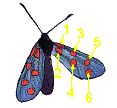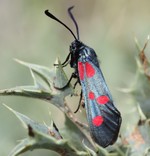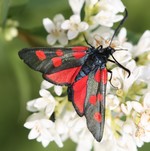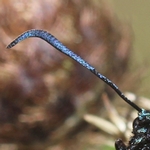

 |  | |||||
| numbering of the spots | ||||||
| choice A |  |
|  | Zygaena filipendulae (5-spotted form) | ||
| choice B |  |
|   | Zygaena lonicerae  Zygaena trifolii should be considered if a specimen does not show all the typical features of Z.lonicerae, given the fact that in some French populations of Z.trifolii, a part of the individuals show spots No.3 & No.4 well separated. Therefore this latest feature must be assessed on several individuals before any definitive conclusion. In case of doubt, specialists recommend to check the genitalia (on females) in order to make the difference between Z.lonicerae and Z.trifolii. Zygaena trifolii should be considered if a specimen does not show all the typical features of Z.lonicerae, given the fact that in some French populations of Z.trifolii, a part of the individuals show spots No.3 & No.4 well separated. Therefore this latest feature must be assessed on several individuals before any definitive conclusion. In case of doubt, specialists recommend to check the genitalia (on females) in order to make the difference between Z.lonicerae and Z.trifolii. | ||